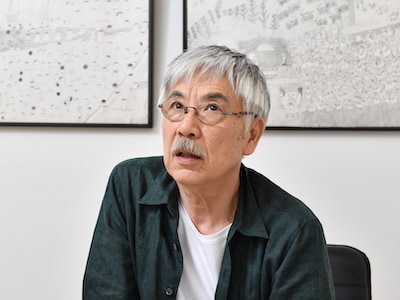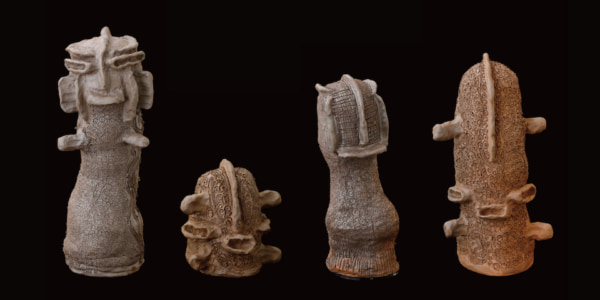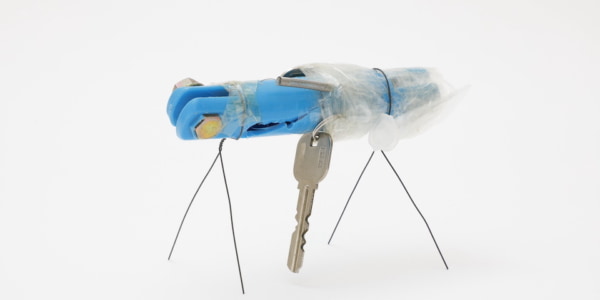Co-starring
KARIMATA Akihiro(1981-)
Karimata lives in Okinawa Prefecture. Since he was a schoolchild to today, he has never tired of drawing busses and bus drivers. The massive amount of information he puts into his works, drawing not only just busses but also drivers, bus-side advertisements, their destinations, and even their routes with great affection makes his pieces unique. Since being introduced in the Soboku no Daichi-ten exhibition in 2001, he has gained attention inside the prefecture and beyond and been featured in numerous exhibitions. He was also invited to the Art Brut Japonaise exhibition held in Paris in 2010. (Art Camp 2001, Executive Committee, ASATSUMA Akira)
![[Photograph (Works)]](https://www.diversity-in-the-arts.jp/admin/wp-content/uploads/2021/12/1532803a1395899d08da59d7caf23105.jpg)
“Bus Route Series” / 380×539mm / Ballpoint pen and crayon on paper / 1998 – 2000 / Collection of The Nippon Foundation
This is story I imagined wholly on my own. Note that I am a lover of the absurd.
The system of busses leaving from a stop and driving around until reaching an end point is the same in Tokyo or Kyoto or anywhere. On such networks, busses run according to schedule.
Meanwhile, people who work at companies are connected to all sorts of things with their company as the origin point, and these too, are networks. In the same way, I believe that everyone today lives their life in networks, and bus networks are one of these. This holds true for actual bus systems, but every person also creates these kinds of systems in their heads, and each walks around inside these systems of theirs.
In this kind of a world, there was a detective. He was following a guy who was aiming to hijack a bus. This bad guy had created the perfect bus-jacking plan, and now all he needed to do was to put it into action. Because the police didn’t seem interested in investigating the case in earnest, the detective thought to himself, I’m the only one who’s gonna catch this guy.
![[Photograph (Works)]](https://www.diversity-in-the-arts.jp/admin/wp-content/uploads/2021/12/9e6762a5c8095e4a26442143c595553e.jpg)
“Toyo Bus Route Bus ¥240,000 Do Your Best” / 380×539mm / Ballpoint pen, crayon, and correction fluid on paper / 1998 / Collection of The Nippon Foundation
However, he had so little information there was nothing he could do, and so the detective rode all sorts of busses around the country. He transferred across bus networks all over the country to try and get an idea of every bus system there was. The criminal, however, just couldn’t be found. Thereupon the detective heard a rumor that he happened to be in Okinawa.
The detective had overlooked Okinawa, a tropical paradise where one would think crime would never happen. Thinking such thoughts, the detective went to Okinawa, and he decided that he should become a bus driver and work as one. It was also possible that the bus-jacker had also become bus drivers. If so, he thought that by becoming a bus driver himself, he would immerse himself deep in the network and possibly gain information.
![[Photograph (Works)]](https://www.diversity-in-the-arts.jp/admin/wp-content/uploads/2021/12/c915390b971ace1ffc3bebd06a8197de.jpg)
“Bus Driver Series” / 376×540mm / Crayon and permanent marker on paper / 2000 / Collection of The Nippon Foundation
So even when he was eating in the cafeteria, he’d think to himself,
“He might be the bus-jacker.”
“Now wait, he might be.”
And so he kept a watchful eye each day. That being said, years had passed since he had the rumor about the hijacker; he must be rather old by now. That’s right; in other words, so, too, had the detective become an old man.
The detective spent years looking at the faces of various old bus drivers, thinking to himself,
“That guy must look like this by now.”
“This guy might be what that guy became.”
So thinking, the detective realized that his own face had become like that.
Because the bus driver stealthily took pictures and carried around the photos of various bus drivers’ faces. Then somehow a photo that had stealthily been taken of him got mixed in and he became unable to tell the difference between the criminal and himself.
“Wait, is that me?” he thought.
![[Photograph (Works)]](https://www.diversity-in-the-arts.jp/admin/wp-content/uploads/2021/12/626a640bff2da8fb298520cf8a03cf50.jpg)
“Bus Driver Series” / 379×540mm / Crayon, permanent marker, and watercolor on paper / 2000 / Collection of The Nippon Foundation
Coming to his senses, he thought, “Who am I after again?”
He had been after the bus-jacker, but now that he thought about it, are not bus drivers also bus jackers?
“Which means that I’m a bus-jacker, aren’t I? I may be driving the set route, but the passengers’ lives are in my hands. That’s bus-jacking then, isn’t it. Then who have I been chasing, and for what reason…” He had completely lost himself.
![[Photograph (Works)]](https://www.diversity-in-the-arts.jp/admin/wp-content/uploads/2021/12/a87b001d073b6cdca3e15a4a29d5f598.jpg)
“Bus Driver Series” / 270×380mm / Crayon and permanent marker on paper / 2000 / Collection of The Nippon Foundation
Amid this confusion, he was driving a bus and saw some pleasant-looking vacant lots and alleyways and thought, this was enough. It wouldn’t be so bad just being a proper bus driver until the end in Okinawa, he thought.
He wondered what ultimately happened to the bus-jacker. Perhaps what he had been chasing was himself. This kind of story was quite popular for a time. Like “Waiting for Godot” by Samuel Beckett. Godot ultimately never arrives, and neither did the bus-jacker. Maybe the bus-jacker was actually him. Maybe I wanted to be a bus-jacker, he thought while cheerily driving the bus.
The former detective, now bus-jacker, continued to live in the network as a responsible adult while at the same time engaging in immoral bus-jackings. In other words, he was stuck in an absurd network, in the old, oft-told story of the chaser being the chasee, the chasee being the chaser.
![[Photograph (Works)]](https://www.diversity-in-the-arts.jp/admin/wp-content/uploads/2021/12/485057595835a99c5d424640672ef3b8.jpg)
“When You Graduate, Bus Driver, Do Your Best” / 380×540mm / Ballpoint pen, crayon, and correction fluid on paper / 1998 – 2000 / Collection of The Nippon Foundation
But this just wouldn’t do in a chaffing metropolis. Perhaps once he noticed the absurd network, he might have decided to quit everything all together and stopped being a bus driver. The world inside the network, however, was peaceful, and he wouldn’t want to give that up. In Okinawa, both could exist side-by-side, and he came to think he needed nothing more.
Perhaps he arrived in Okinawa because that was where he was meant to go. Maybe, he thought, I was the one who spread the rumor about the criminal being in Okinawa. Perhaps he would get married in Okinawa and tell that to his child. His child would be pretending to be a bus driver, and he would say to him, now I am a bus driver, but I used to be a detective. And he would tell his child, you should be a bus driver from the start; you don’t have to be a detective first like your dad. You can become a bus driver right away, he would say. Because it’s better to make your networks and connections simple.
“How about I set up a bus stop in front of your school, and send you off and pick you up from there?”
Issey Ogata’s Wildly Imaginative Art Appreciation Techniques
As actor, playwright, and director of his one-man show, Issey Ogata brings new worlds to life every day. We asked him for tips on having fun with the power of unfettered imagination.
![[Photograph]狩俣明宏さんの作品を手にこちらを見つめるイッセー尾形さん](https://www.diversity-in-the-arts.jp/admin/wp-content/uploads/2021/12/A2A9976.jpg)
In Tokyo, busses are almost never a part of my life, but when I perform regionally, I often become aware of busses. In Hakata, Nishitetsu busses run like a flood. Kyoto’s busses have subdued colors so they don’t stand out, but I think this gives them a presence. Even as they blend in with the town.
Okinawa is another place where I notice busses. Because there’s no train, everyone uses busses or taxis. The taxis are also in colors you don’t see in Tokyo, and you often see old women with parasols lined up waiting for busses. I have a story from when there was a little theater in Okinawa called the Jan Jan. It closed in 2000, but I went there a lot in Okinawa.
![[Photograph]](https://www.diversity-in-the-arts.jp/admin/wp-content/uploads/2021/12/A2A9958.jpg)
Issey looking at the works.
I love the vacant lots in Okinawa. There will be a little lane between buildings in the back, a plot of land covered in white sand hit by the sun. A back alley. I always think those are so nice when I see them.
That scenery is on the same level as the feeling of relaxation to me. In other words, these back alley vacant lots are like the feeling of relaxation turned into scenery to me. The feeling and the scenery are a perfect match, I think. I think the reason why I feel relaxed in Okinawa is because those kinds of vacant lots dot the area.
That’s why when I saw the works for this story, I felt the setting was in Okinawa, and that brought back these memories. And I felt like I was looking at those vacant lots. And looking from one of these vacant lots, you might see one of these busses running by.
![[Photograph]作品を見つめる横顔のイッセー尾形さん](https://www.diversity-in-the-arts.jp/admin/wp-content/uploads/2021/12/A2A9906.jpg)
There was a time when we read a lot of absurdist texts and Kafkaesque literature. They wouldn’t consist of an introduction, development, twist, and conclusion like regular romance novels. They’d just be super-introduction and then twist, twist, twist, twist, twist. Ionesco’s plays and Sartre’s “Nausea” and existentialist works are like that, too. Coupled with the student movements and new left movements, this idea that things wouldn’t go according to the conventional rules was a driving force for young people.
And there was also this absurd belief by some people that those who didn’t understand this absurdism were stupid. It was a time of absurdist sycophants, haha.
Whatever you absorbed a lot of when you were young sticks around when you’re old. There’s no point in living your life denying those times, so I affirm it all and still cultivate absurdity. Because otherwise it will lose all meaning.
And that’s how this story’s “The Absurdity-Lover’s Network” was born.
![[Photograph]思案しているイッセー尾形さん。](https://www.diversity-in-the-arts.jp/admin/wp-content/uploads/2021/12/A2A9989.jpg)
[Corporation] Yanaka no Okatte, NPO Taito Cultural & Historical Society, Ueno-Sakuragi Denchu Hirakushi House and Atelier




![[Photograph] ほうきを手に上を見上げるイッセー尾形さん](https://www.diversity-in-the-arts.jp/admin/wp-content/uploads/2021/12/A2A91361600.jpg)



